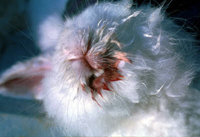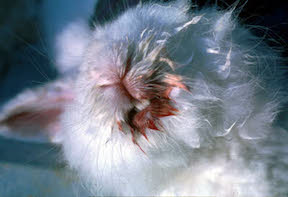Case is first in U.S. caused by rabbit hemorrhagic disease virus 2; source unknown

rabbit

Noah's Arkive photo/C.L. Davis and S.W. Thompson DVM Foundation
A laboratory rabbit is afflicted with rabbit hemorrhagic disease in this image from Chonnam National University in South Korea.
Rabbit hemorrhagic disease virus 2 has been confirmed in Ohio, the first known case in the United States.
The infected rabbits were on a farm in rural Medina County, south of Cleveland. The virus, known as RHDV2, is highly contagious and typically fatal in rabbits but does not sicken humans or other animals.
The disease was detected Sept. 19, according to the Ohio Department of Agriculture (ODA). Four of five rabbits that ran free among horse stalls on the farm have died. One rabbit is still alive and under quarantine, reported ODA. None of the animals had been transported off the premises prior to becoming sick, and they had lived on the farm for years.
“Epidemiologists are trying to determine how this infection started,” said Eric Stewart, executive director of the American Rabbit Breeders Association (ARBA). “But we may never know where it came from.” ARBA works closely with the U.S. Department of Agriculture and state animal health agencies on issues relating to rabbits. Stewart described his organization as “quite concerned” about this report.
RHD is a highly contagious viral disease that causes sudden death in rabbits. It is also known as rabbit viral sudden death, X-disease of rabbits, hemorrhagic septicemia syndrome in rabbits, viral hemorrhagic pneumonia in rabbits and rabbit viral hemorrhagic disease. There are many strains of RHDV and three major viral subtypes: RHDV (or “classical RHDV”), RHDVa and RHDV2 (sometimes called RHDVb).
Rabbits can contract the virus through contact with infected rabbits or with other animals or materials — such as food, water, bedding and vehicles — that have been in contact with infected animals. According to the USDA, a very low dose, possibly as little as a few virus particles, is enough to cause infection. The virus is highly stable, especially in organic materials, and can remain active for months in varied temperatures and over distances, enabling it to be spread by biting insects.
Vaccines exist for RHD but are not approved for use in the U.S. The best way to protect rabbits is with enhanced biosecurity practices, such as by not sharing equipment with other rabbit owners; and by disinfecting all equipment, such as waterers and feeders, that come into contact with rabbits. Treatment is limited to supportive care, with infected rabbits isolated from all other animals.
The time from infection to first signs of disease may be up to nine days, according to ODA. Affected rabbits may develop a fever and die within 36 hours. Infected rabbits may appear dull and be reluctant to eat; have congested membranes around the eyes; show signs of nervousness, incoordination or excitement; and/or make paddling movements. They may have trouble breathing. Upon death, they may have a blood-stained, frothy nasal discharge.
Infection with RHDV causes lesions throughout internal organs and tissues, particularly the liver, lungs and heart, resulting in bleeding. Mortality rates ranging from 5 to 70 percent have been reported for RHDV2.
Wild and domesticated European rabbits (Oryctolagus cuniculus) are susceptible to RHD, according to an Iowa State University report on the disease. This is the only species of rabbit to have been widely domesticated, and all types of commercially bred or farmed rabbits in the United States are genetically related.
While there is no official count of domesticated rabbits in the U.S., Stewart estimates there may be as many as 2 million. In addition to being kept as pets, rabbits are raised as livestock for meat and fur.
Common American wildlife species known as the cottontail, snowshoe hare and black-tail jackrabbit are not susceptible to RHD, according to the USDA.
The disease’s origins are not completely understood. RHD was first reported in China in 1984. According to the Iowa State University report, it was spread by angora rabbits imported from Europe. During the outbreak, 14 million domesticated rabbits died in nine months.
RHDV is endemic in Australia and New Zealand, where it was introduced illegally to control the wild rabbit population, as well as in Cuba, parts of Asia, Africa and much of Europe, according the USDA. Outbreaks also have occurred in domestic rabbits in the Middle East.
Isolated cases have appeared intermittently in the U.S.: in Iowa in 2000; Illinois, New York and Utah in 2001; Indiana in 2005; Maryland in 2008; and Minnesota in 2010. In March 2011, a report of RHDV in Manitoba was the first in Canada.
The subtype found in Ohio this month, RHDV2, was first identified in France in 2010. It has since spread widely among domesticated and wild rabbits in Europe and also has been found in Australia. In March, RHDV2 was reported in rabbits on Vancouver Island, British Columbia, and in Delta and Richmond on the mainland, not far from the U.S. border. This was a serious outbreak, in part because it spread to a large population of feral domestic rabbits, Stewart said.
Although RHDV2 does not pose a threat to humans, other animals or the food supply, the World Organization of Animal Health, the international governing body for animal health, requires that it be reported. USDA reported the Ohio case on Sept. 21.
Correction: This story has been revised to show that Illinois, not Michigan, reported an occurrence of RHDV in 2001.
Update: According to the Ohio Department of Agriculture, as of Jan. 16, 2019, there are no longer any domesticated rabbits on the farm where rabbit hemorrhagic disease was found, and no more cases have been reported in the state. In addition, no evidence of the virus has been found in the wild population. The department said it is "confident" the virus was isolated at the farm. The route of transmission there is still unknown.